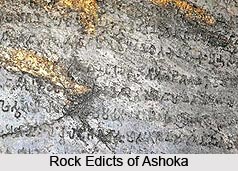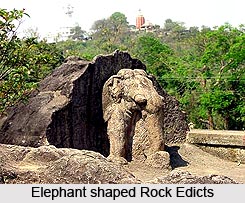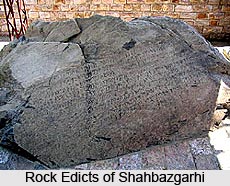 The Rock Edicts of Ashoka are the inscriptions containing King Ashoka`s ideals and philosophy written over rocks, which are present all over North India. The Ashokan Rock Edicts are basically a collection of 33 inscriptions that are carved on the pillars of Ashoka or on the big boulders or on caves. The ancient rock edicts are not modified in anyway and are preserved in the way they were carved originally.
The Rock Edicts of Ashoka are the inscriptions containing King Ashoka`s ideals and philosophy written over rocks, which are present all over North India. The Ashokan Rock Edicts are basically a collection of 33 inscriptions that are carved on the pillars of Ashoka or on the big boulders or on caves. The ancient rock edicts are not modified in anyway and are preserved in the way they were carved originally.
The rock edicts of India are found in many places of northern India as well as Pakistan. Ashoka was a great follower of Budhhism and these edicts support his effort to spread Budhha`s word in different places of his sovereign. According to the information provided by the rock edicts of Ashoka Buddhism spreaded as far as Mediterranean as well as Srilanka outside his monarch. Many Buddhist monuments and temples were constructed during this period in order to promote this peaceful religion and make the world aware of Lord Buddha`s teaching and philosophy.
The rock edicts declare emperor Ashoka`s faith in the concept of Dharma or Righteousness. The inscriptions not only focus on religious aspects but also on social and moral concepts. However rock edicts do not mention the Four Noble Truths or the Eight Fold Path to Nirvana. The probable cause behind this Ashoka wanted to remain simple in his approach to Budhhism and wanted to connect with the common men.
Ashoka describes himself in the rock edicts as `Beloved of Gods` and `King Priya-darshi`. An inscription discovered in the year 1915 on a rock edict confirmed the identification of king Priya-Darshi with Ashoka. The language used in these edicts is mainly Pali. But they are also written in different other languages as they were spread through a vast region. As for example the inscriptions found on the eastern part of India were written in Magadhi Language, using the `Brahmi` script. In the western part of India the language used is closer to Sanskrit, which used the `Kharoshthi` script. The edict 13 was written in Greek language and the other bilingual edict written in Greek and Aramaic.
The Major Rock Edict of Ashoka is found out of the town of Junagadh on the Saurashtra peninsula in the state of Gujrat in India. The edict is high up on a large, domed mass of black Granite stone on Girnar hills. The difficulty in climbing the hills allows only few Jain monks or pilgrims to visit the edict. This neatly etched rock edict is inscribed with `Brahmi` script.
The different places where Ashoka`s Rock Edicts were found are-Allahabad-Kosam, Bairat, Barabar hill caves, Broach, Brhmagiri,Delhi-Meerut, Dhauli, Gavimath. Girnar,Gujjara, Jatinga-Rameshwar, Jaugada, Kalsi, Kandanar, Lampaya, Lauriya-Araraj, Lauriya-Nandangarh, Mahasthan, Mansehra, Maski, Nigali-Sagar, Palkigundu, Pataliputra, Rajula-Mandagiri, Rampurya, Rummindei, Rupanath, Sahasram, Sanchi, Sarnath, Shahbazgarhi, Siddapur, Sohgaura, Sopara, Suvarnagiri, Tamralipti, Taxila,Ujjain, Yerragudi.



















